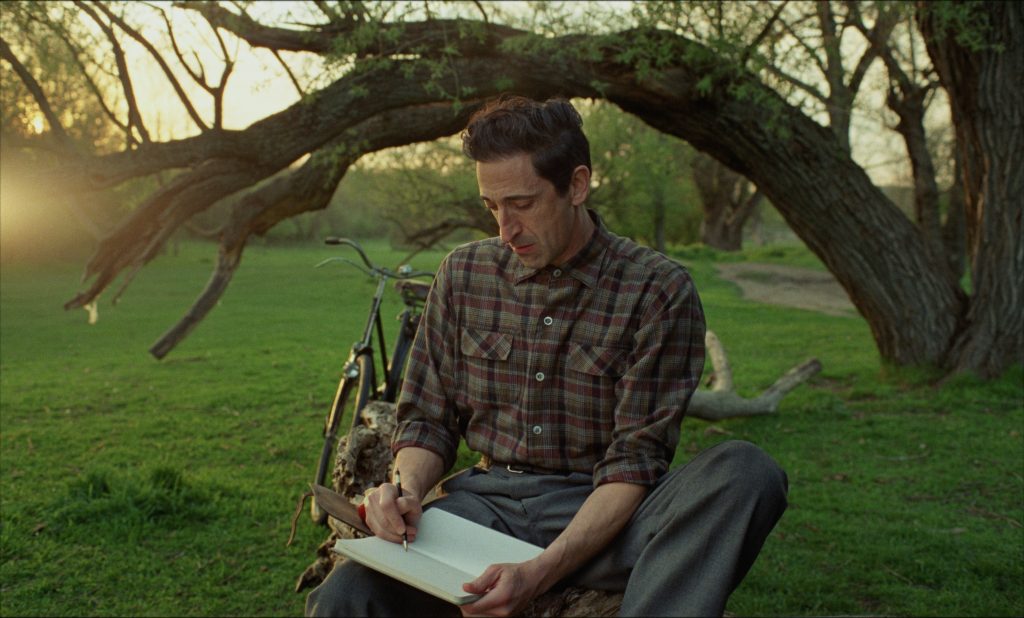‘The Brutalist’ Is Powerful, Thoughtful Epic
Nominated for 10 Oscars, including best picture and best actor, it's brilliant.
Expanding the Oscar “best” list to 10 nominated films has changed forever the Academy of Motion Picture Arts and Sciences and its nearly 10,000 voting members.
Oscar – now scheduled March 2 — is trying to make sure that list now incorporates box office values along with the industry view of top meaningful pictures – which means that this year Oscar announced a range of genre films as well as independent features, including some not yet seen in Milwaukee.
In this environment, there seems to be growing admiration for The Brutalist, which clearly has the desire of Oscars’ past – that sense of a sweeping epic. It is a gripping compilation of acting values and cinematic techniques, only available for now in movie theaters.
You will hear a lot about the intense naturalism and subtle reactions of Adrien Brody (a leading nominee for best actor Oscar) but the acting scenes are rapidly interwoven with purposeful sequences where the visual and audio expertise take over:
Cameras speeding down roads and train tracks much as new arrivals in this country experienced; immigrants packed into ships seeing the Statue of Liberty upside down; male newcomers after World War II relieving themselves at brothels and on street corners; blocks upon blocks of landscapes put together in rapid editing as the film moves from Pennsylvania to Italian quarries; travelogues in the style of old Hollywood short subjects; examples of Brutalism architectural form illustrated by interwoven wires; and a brilliant sound background.
Composer Daniel Blumberg’s lush European orchestral eye-openers and pounding chords alternate with vintage tracks (Dinah Shore singing “Buttons and Bows,” a JFK interview in a whispering background) for events centered on 1947 to 1961, plus an epilogue in 1980.
The soundscape serves a dynamic role as envisioned by director Brady Corbet, also co-author and producer, and one of my favorite nominees for best director. (This year is notable for best directors who are Oscar choices for the first time.)
Corbet, 36, is new to most filmgoers, but is truly a Hollywood baby, having started as a child actor and voice-over actor before moving into TV and film acting roles and then into producing-directing. The result is an astonishing and intellectual command of the cinematic universe, plus inventing a story that is based on history but is pure imagination. The lead character László Toth is not a historic person, but is based on many Brutalist architects put together and by many immigrant experiences.
In promotional material for the movie – including pretending there is a László Toth-designed Margaret Van Buren Center for Creation and Activity — Corbet has provided a compelling cover ethic (including postcards) to make the story feel real.
Brutalism in architecture was a serious movement associated with post-war society if you count both world wars. Corbet largely invents the pretense that Toth’s Brutalist designs – heavy on concrete building blocks and geometric exactitude — were inspired by German concentration camps.
There are handouts to the audience of this promotional material on Toth (at least in the 70-millimeter showings, blown up from the 35 mm the film was shot in, plus a deliberate 1950s VistaVision screen size to further deepen Corbet’s idea of bringing the old era to life).
The movie presents Toth, played by Brody, as a celebrated architect from the Bauhaus movement who survives a Buchenwald concentration camp, leaving his wife behind. An incessant smoker and drug addict (partly for physical pain), he is one of the flood of refugees after WWII forced to work as a laborer or draftsman. He relies on relatives who know his stature and take advantage of it – relatives who have Americanized their names and cheapened their Jewish past to fit in. So they are quick to renounce him and his hooked nose when a volatile rich American (the cleverly named Harrison Lee Van Buren Sr.) accuses him of fraud.
Brody’s performance is compellingly natural – an intellectually stubborn, sarcastic and believable modernist who stands up for his training yet is also drawn to the power of money despite his fury and disappointment. He doesn’t regard visiting prostitutes as negating his love of family. Brody’s performance, seen often in facial closeups even during sexual activity, is serious and believable. (Need I point out there are adult themes, even sexually disturbing ones.)
At the story unfolds, the same American who scorned him re-emerges contrite and eager for Toth to build a shrine to his late mother. Van Buren is a dominant control freak attempting to talk to Toth as an intellectual equal, recognizing he will get great press by commissioning serious architecture. This villain role has won a best supporting actor nomination for Guy Pearce, who is not bad though I confess I longed to see what the original actor sought for the part, Mark Rylance, would have done with the role.
The story depends on our understanding that Van Buren is the ultimate ugly American, whose act of violence toward Toth triggers much of the finale (by this point we understand the moral implications and hardly need the incident to deepen our understanding, though it is nice that the film lets Van Buren disappear off screen as anger rings around him).
Felicity Jones emerges halfway through the film as Toth’s wife, crippled by years of famine. It is an intelligent performance – also Oscar nominated — relying on emotional honesty as well as humane support of her husband. The conclusion is something we understand in its moral meaning while we may not buy all the events and techniques in its unfolding.
But this is a brilliant film despite my reservations, even though divided into somewhat fancy sounding chapters: Overture, The Enigma of Arrival, The Hard Core of Beauty and Epilogue: The First Architecture Biennale.
You may be daunted hearing of its three-hour 35-minute length plus a 20-minute intermission (with a time clock on the screen to make us look hard at the family portrait before us). I would have liked the intermission about an hour later, when I found the film stretching a bit, but the placement is just right for the concept.
The length and bustle onscreen will not interfere with the audience’s thinking while absorbing. The film indirectly made me contemplate what the recent L.A. wildfires revealed about the fleeting value of most American wealth and architecture – a big point in the film.
Van Buren’s fascination with his own worth makes us look again at our current view of wealthy Americans and corporate bullies. The painful efforts at human connection make us think back at what really creates our motives and our goals.
It is a further effort by Corbet to make us aware we are on a journey to understanding American society as well as how the past helps shape it. It is a necessary rather than a brutal cultural lesson.
The Brutalist is still playing at several movies theaters in town.
Dominique Paul Noth served for decades as film and drama critic, later senior editor for features at the Milwaukee Journal. You’ll find his blog here and here.
If you think stories like this are important, become a member of Urban Milwaukee and help support real, independent journalism. Plus you get some cool added benefits.
Review
-
Dylan Biopic ‘A Compete Unknown’ Is Lovable Mythology
 Feb 9th, 2025 by Dominique Paul Noth
Feb 9th, 2025 by Dominique Paul Noth
-
Transfer Has Great Pizza
 Feb 2nd, 2025 by Cari Taylor-Carlson
Feb 2nd, 2025 by Cari Taylor-Carlson
-
‘The Woman In Black’ Is Masterful Suspense
 Jan 27th, 2025 by Dominique Paul Noth
Jan 27th, 2025 by Dominique Paul Noth
Theater
-
‘The Woman In Black’ Is Masterful Suspense
 Jan 27th, 2025 by Dominique Paul Noth
Jan 27th, 2025 by Dominique Paul Noth
-
‘The Craic’ Bursts With Irish Music and Spirit
 Jan 22nd, 2025 by Dominique Paul Noth
Jan 22nd, 2025 by Dominique Paul Noth
-
What a Tale of Woe Is ‘Juliet and Romeo’
 Jan 20th, 2025 by Dominique Paul Noth
Jan 20th, 2025 by Dominique Paul Noth




















